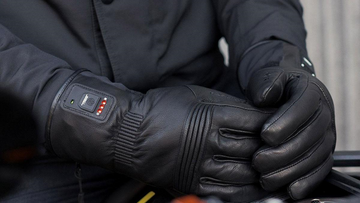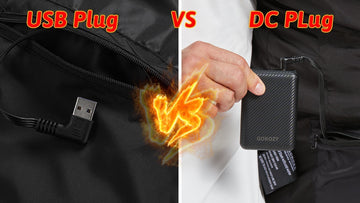As winter approaches and temperatures drop, keeping your hands warm becomes a top priority, especially if you spend time outdoors. While traditional gloves can do the job, heated gloves offer a modern solution that promises consistent warmth even in the harshest conditions. But are they really worth the investment? In this blog, we’ll explore the pros and cons of heated gloves to help you decide if they’re the right choice for you.
How Do Heated Gloves Work?
Heated gloves use built-in heating elements to generate and distribute warmth evenly across your hands and fingers. These elements are powered by rechargeable batteries, which are usually integrated into the gloves themselves or connected via small battery packs. The ability to control the level of heat provides a customized experience, making these gloves especially useful in varying weather conditions.
Benefits of Heated Gloves
Consistent Warmth
The primary advantage of heated gloves is their ability to provide consistent warmth. Unlike traditional gloves that rely on insulation to trap body heat, heated gloves actively generate warmth, ensuring your hands stay toasty even in freezing temperatures. This is particularly beneficial for people who suffer from cold-related conditions like Raynaud’s disease, where blood flow to the extremities is limited in cold weather.
Comfort and Flexibility

Heated gloves are designed to be lightweight and comfortable, offering warmth without the bulkiness of heavy winter gloves. Many models come with adjustable heat settings, allowing you to choose the level of warmth that suits your needs. Whether you’re skiing down a mountain or simply walking the dog on a chilly morning, heated gloves provide a level of comfort that traditional gloves can’t match.
Health Benefits
For those with conditions like arthritis or poor circulation, heated gloves can offer significant relief. The consistent warmth helps improve blood flow, reducing pain and stiffness in the hands. This makes heated gloves not just a luxury, but a necessity for some individuals during the winter months.
Suitability for Various Activities
Heated gloves are versatile and suitable for a wide range of outdoor activities. Whether you’re skiing, hiking, biking, or even just shoveling snow, these gloves keep your hands warm and functional. They are particularly beneficial in activities where maintaining dexterity and warmth simultaneously is crucial.
Potential Drawbacks
High Cost
One of the main drawbacks of heated gloves is their cost. They are significantly more expensive than traditional winter gloves, which can be a barrier for some buyers. The initial investment includes the gloves themselves, and over time, you may need to replace batteries or chargers, adding to the overall cost.
Battery Life

Battery life is another consideration. Depending on the heat setting, most rechargeable heated gloves provide warmth for 2 to 8 hours per charge. While this is generally sufficient for a day’s activities, it can be inconvenient if the battery runs out in the middle of an outdoor adventure. You’ll need to remember to charge the batteries regularly, and it’s a good idea to carry spare batteries if you’re planning to be outside for an extended period.
Maintenance and Care
Heated gloves require more care than regular gloves. They often come with specific washing and drying instructions to avoid damaging the heating elements and battery connections. This extra maintenance can be a hassle, especially for those who prefer low-maintenance winter gear.
Durability
Durability is another potential issue. While most heated gloves are built to last, the electronic components can wear out over time, especially with frequent use. This means you might need to replace them more often than you would with traditional gloves, adding to the long-term cost.
Bulkiness
Although heated gloves are designed to be comfortable, some models can be bulkier than regular gloves. This bulkiness can reduce dexterity, making it more challenging to perform tasks that require fine motor skills, such as handling small objects or using tools. If you need maximum dexterity for your activities, this could be a significant downside.
Comparing Heated Gloves to Regular Winter Gloves
Warmth and Comfort
When it comes to warmth, heated gloves clearly have the upper hand. While regular winter gloves rely on insulation, heated gloves generate their own warmth, making them far more effective in extreme cold. This is particularly important in sub-zero temperatures where traditional gloves may fall short.
Dexterity and Mobility
Regular winter gloves typically offer better dexterity due to their slimmer design. However, they may not keep your hands as warm as heated gloves in very cold conditions. The bulkiness of some heated gloves can make certain tasks more difficult, so it’s important to choose a pair that balances warmth with mobility.
Use in Extreme Conditions
In extremely cold conditions, heated gloves outperform regular gloves by a wide margin. If you live in or frequently visit areas with severe winters, heated gloves are a worthwhile investment to ensure your hands stay warm and functional.
Who Should Consider Buying Heated Gloves?
Outdoor Enthusiasts
If you enjoy outdoor activities such as skiing, hiking, or biking, heated gloves are a great investment. They provide consistent warmth and allow you to stay outside longer without discomfort.
Individuals with Medical Conditions
For those with medical conditions like Raynaud’s disease or arthritis, heated gloves can be a game-changer. The warmth they provide can help alleviate symptoms and make winter more manageable.
People in Extremely Cold Climates
If you live in a region with harsh winters, heated gloves can be more of a necessity than a luxury. They offer the warmth needed to keep your hands protected and comfortable in sub-zero temperatures.
Alternatives to Heated Gloves
High-Quality Insulated Gloves
If heated gloves seem too costly or cumbersome, high-quality insulated gloves are a good alternative. These gloves use advanced insulation materials to trap heat, providing warmth without the need for batteries.
Hand Warmers
Hand warmers, whether disposable or reusable, are another alternative. They can be slipped into regular gloves for added warmth, though they don’t offer the same consistent heat as heated gloves.
Conclusion
Heated gloves offer significant benefits, including consistent warmth, comfort, and health advantages, making them an excellent choice for many people. However, they come with drawbacks such as high cost, maintenance needs, and potential bulkiness. Whether they’re worth buying depends on your individual needs, lifestyle, and how much time you spend outdoors in the cold. For those who need reliable warmth in harsh conditions, heated gloves are definitely worth considering.
FAQs
How long do the batteries last in heated gloves?
Battery life typically lasts between 2 to 8 hours, depending on the heat setting and model.
Can heated gloves be washed?
Yes, but follow the manufacturer’s care instructions carefully. Always remove the batteries before washing. Check how to wash your heated gloves
Are heated gloves safe to use in wet conditions?
Most heated gloves are water-resistant, but it’s essential to check the product specifications. Ensure the batteries and electrical components are adequately protected.
Do heated gloves work in extreme cold?
Yes, heated gloves are specifically designed to perform well in very cold conditions, offering warmth that traditional gloves might not provide.
What should I look for when buying heated gloves?
Consider factors such as battery life, heat settings, durability, and comfort. Choose a pair that fits well and meets your specific needs.






